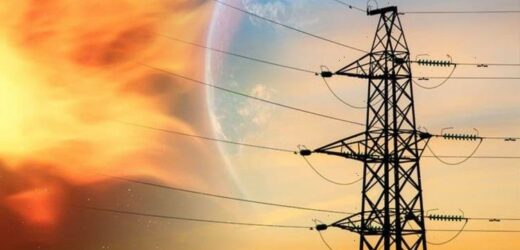Dominic Cummings discusses solar flares
We use your sign-up to provide content in ways you’ve consented to and to improve our understanding of you. This may include adverts from us and 3rd parties based on our understanding. You can unsubscribe at any time. More info
The G2-level solar storm, also known as a coronal mass ejection (CME), struck the Earth’s magnetic field on October 12 at approximately 3:30am.
But while the CME has already struck, it is still unclear what the full extent of the damage could be.
Mathew Owens, Professor of Space Physics at The University of Reading told Express.co.uk: “A CME is like a big eruption from the Sun that comes to Earth.
“It’s a bit like a snowplough in that it pushes all the material ahead of it.
“At the moment the Earth is still sat in those piles of snow ahead and we haven’t really hit the main storm.
“The next few hours will tell us how the storm will develop.”
And with the potential impacts still lingering, there are fears of power grid fluctuations with voltage alarms at higher latitudes.
Solar storms are ranked from G1 to G5 in intensity and geomagnetic force from lowest to highest, but Express.co.uk has been told that even a “moderate” storm like this can cause disruption.
Professor Owens added: “I think it’s going to stay around a G2 moderate storm, when you have a storm there’s a bigger likelihood of a spacecraft having problems.


“Power companies probably won’t be scheduling any maintenance on the power grid for the next 24 to 48 hours because the load on your power grid will be slightly higher than normal.
“It is not impossible that there will be a brief power shortage in the UK, but at a higher latitude, it will be felt much stronger.
“We have to worry about the much stronger events.”
And even though this is not in the highest category solar storm, this is still likely to cause some damage to power systems even if it does not knock it out completely.
Professor Owens warned: “While it may not knock out a spacecraft or power system, it does increase the wear and tear on our power system.
“The more little storms like this that we have, the more maintenance we will need to do on power systems.”

The US Space Weather Prediction Center (SWPC) also said the G2 storm could bring with it power grid fluctuations, voltage alarms, increase drag on low-Earth satellites and mess with radio frequencies, posing a serious risk to global communications in the worst-case scenario.
But while GPS signals and radio communications could still be a worry, the storm also brings with it something more positive.
DON’T MISS
Mystery illness outbreak: Six dead as investigation launched [REAVEAL]
Space breakthrough as exoplanet discovery ‘similar’ to Earth [INSIGHT]
Flu jab panic as UK pharmacies ‘run out of stock’ [REPORT]


Accompanying the CME, lucky spectators across the global were able to catch a glimpse of the spectacular Northern Lights aurora as a result of the solar storm.
And Aurora Alerts UK even issued a “red alert” at 7:23am when they said that the Northern lights could even be spotted in the northern parts of Britain and could continue tonight as the storm continues to build.
Source: Read Full Article

